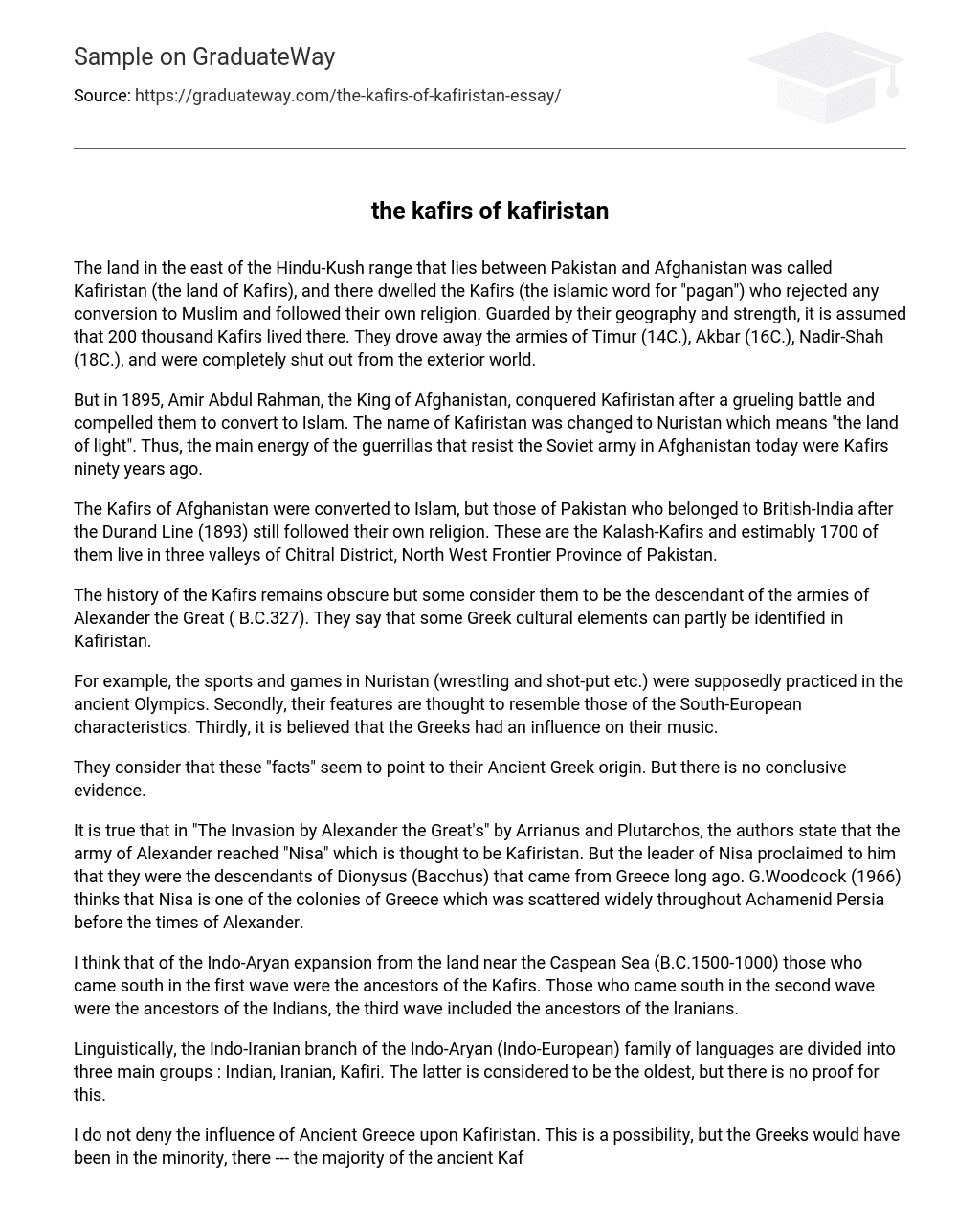Situated between Pakistan and Afghanistan, the eastern region of the Hindu-Kush range was home to a land called Kafiristan. The inhabitants of this land were the Kafirs, who were referred to as “pagan” in Islamic terms but firmly rejected conversion to Islam and instead held onto their own religious beliefs.
About 200 thousand Kafirs resided in this strategically located region, benefiting from both its geography and military strength. They successfully defended against multiple invasions throughout history, including those led by Timur in the 14th century, Akbar in the 16th century, and Nadir-Shah in the 18th century. As a result, they remained isolated from external influences and untouched by the outside world.
In 1895, King Amir Abdul Rahman of Afghanistan conquered Kafiristan and forced its people to convert to Islam. The name of Kafiristan was changed to Nuristan, meaning “the land of light.” As a result, the guerrillas currently opposing the Soviet army in Afghanistan were once known as the Kafirs almost one hundred years ago.
The Kafirs of Afghanistan and Pakistan, who were part of British-India after the Durand Lime (1893), converted to Islam. However, the Kalash-Kafirs, estimated to be around 1700, residing in three valleys of Chitral District, North West Frontier Province of Pakistan, continued to practice their own religion.
The origin of the Kafirs is unclear, but according to some, they may be the descendants of Alexander the Great’s armies in 327 BC. It is believed that certain Greek cultural aspects can still be observed in Kafiristan.
One example of the sports and games in Nuristan, such as wrestling and shot-put, were supposedly practiced in the ancient Olympics. Additionally, their features are believed to resemble those of South-European characteristics. Lastly, it is thought that the Greeks had an influence on their music.
They believe that the presence of these “facts” indicates their Ancient Greek origin, although there is no definitive proof.
According to Arrianus and Plutarchos in “The Invasion by Alexander the Great’s,” it is confirmed that Alexander’s army arrived at “Nisa,” believed to be Kafiristan. However, the leader of Nisa declared that they were the offspring of Dionysus (Bacchus) who originated from Greece in ancient times. G.Woodcock (1966) suggests that Nisa is among the Greek settlements that were dispersed extensively across Achamenid Persia prior to Alexander’s era.
According to my understanding, the Indo-Aryan expansion (B.C.1500-1000) saw multiple waves of migration originating from the area around the Caspian Sea. The first wave included the ancestors of the Kafirs, followed by the second wave which consisted of the ancestors of Indians. Lastly, the third wave involved the ancestors of Iranians.
The Indo-Aryan (Indo-European) family of languages comprises three main groups: Indian, Iranian, and Kafiri. However, there is no evidence supporting the claim that Kafiri is the oldest group.
Although it is possible that Ancient Greece may have influenced Kafiristan, the ancient Kafirs were mostly a different race. However, they did share the same original land as the Greeks. If there was any subsequent influence from Ancient Greece, it would have been readily embraced by the Kafirs because of their common origin.
The Indo-Iranian branch of the Indo-European language family can be divided into three main groups: Indo-Aryan (Indian), Iranian, and Kafiri (the language of the Kafirs). Geographically, Kafiristan is located between India and Iran, causing the language group to have similarities with both Indo-Aryan and Iranian groups. However, it does not have a written script like them. Moreover, the distribution of tribes corresponds to the dialects of Kafir languages such as Kati and Waigali.
However, Kalasha, spoken by the last of the Kafirs, is not in Kafiri. It is part of the Indian group of languages with Khowar (Chitrali) which is spoken in Chitral District. Kalasha is very similar to Khowar and even a small Kalasha child can speak it. Mixed in their language, we can identify Persian words used for abstract concept and modern Urdu for tools and articles etc. At present, about 2000 people speak Kalasha and 250 thousand speak Khowar.
Chitral proper can be reached by either a forty-five minute flight from Peshawar with PIA Domestic Airlines or a two-day journey by road through Dir and Lowarai Pass (3177m).
In the past, the Kafirs occupied the entire Chitral area; however, in the 14th century, they were conquered by the Katur (Metar of Chitral) from Herat, Afghanistan, and were converted to Islam. Nonetheless, a small number of unconverted Kafirs remained in the Shishikui valley in the south of Chitral and Lutkoh valley in the north. However, at the onset of the 20th century, all of them embraced Islam.
The Kafirs now reside exclusively in the three valleys along the branch of Chitral river called Kunar R., including Rukmu, Mumuret, and Biriu (known as Rumbur, Bumburet, and Birir to the local Kalasha people as well as Chitrali people and foreigners). It takes approximately two or three hours to drive by jeep from Chitral proper, but it has gained popularity among tourists as a must-visit destination.
The Kalasha Valleys are home to a large number of Holly-Oak and Himalayan cedar forests. The villages in the area are surrounded by an abundance of Walnut, Apricot, Apple, Pear, and Mulberry trees.
Among the three valleys, Mumret is the largest. It consists of three villages with a population of over 200 each, and two villages with approximately 60 residents. However, the valleys of Rukmu and Biriu are comparatively narrower, and it is believed that their populations are half the size of Mumret’s.
The villages are located on the southern slope of the hill, positioned approximately 50-100 meters above the river. This strategic positioning provides protection against invaders and summer floods while also ensuring ample sunlight during winter. The snow that accumulates in the shaded areas and at the ravine’s bottom persists until spring. During summer, some individuals opt to reside in a secondary house constructed on the opposite side of the river to avoid excessive sun exposure.





